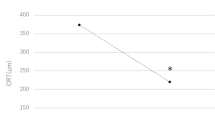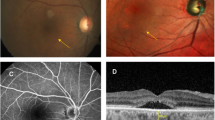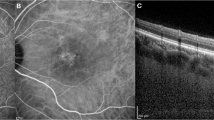Abstract
Background
To investigate the anatomical and functional results in eyes with peripapillary pachychoroid syndrome (PPS) undergoing photodynamic therapy (PDT).
Methods
A total of 25 eyes from 23 patients with PPS treated with PDT were retrospectively evaluated in this multicentric study. Main outcome measure was the proportion of eyes that achieved treatment success, defined as a decrease in both subretinal fluid (SRF) height and central subfield thickness (CST), at 3 months after PDT compared to baseline. Secondary outcomes were the change in CST, SRF, and best-corrected visual acuity (BCVA) 3 months after treatment and predictive factors for treatment success. When available, data between 3 and 12 months were also reviewed.
Results
Treatment success was achieved in 16 eyes (64%). In the total cohort, CST decreased significantly from 356 ± 118 µm at baseline to 282 ± 90 µm and 270 ± 91 µm at 1 and 3 months, respectively (p < 0.001). Maximal SRF height decreased significantly from 102 ± 83 µm at baseline to 38 ± 46 µm and 32 ± 42 µm at 1 and 3 months, respectively (p < 0.001), and remained stable at month 6 (29 ± 44 µm) and month 12 (23 ± 35 µm). BCVA improved significantly from baseline to month 3 (p = 0.021).
Conclusions
PDT can be considered an efficacious treatment option in patients with PPS. Prospective data with longer follow-up in a bigger cohort are needed in order to determine the optimal treatment algorithm in this relatively novel disease.
Similar content being viewed by others

Log in or create a free account to read this content
Gain free access to this article, as well as selected content from this journal and more on nature.com
or
References
Cheung CMG, Lee WK, Koizumi H, Dansingani K, Lai TYY, Freund KB. Pachychoroid disease. Eye. 2019;33:14–33.
Phasukkijwatana N, Freund KB, Dolz-Marco R, Al-Sheikh M, Keane PA, Egan CA, et al. Peripapillary pachychoroid syndrome. Retina. 2018;38:1652–67.
Giray Ersoz M, Arf S, Hocaoglu M, Muslubas IS, Karacorlu M. Indocyanine green angiography of pachychoroid pigment epitheliopathy. Retina. 2017;38:1668–74.
Koizumi H, Yamagishi T, Yamazaki T, Kinoshita S. Relationship between clinical characteristics of polypoidal choroidal vasculopathy and choroidal vascular hyperpermeability. Am J Ophthalmol. 2013;155:305–313.e1.
Iida T, Kishi S, Hagimura N, Shimizu K. Persistent and Bilateral choroidal vascular abnormalities in central serous chorioretinopathy. Retina. 1999;19:508
Peiretti E, Iovino C. Indocyanine green angiography. In: Central serous chorioretinopathy. Burlington: Academic Press; 2019. p. 97–113.
van Dijk EHC, Fauser S, Breukink MB, Blanco-Garavito R, Groenewoud JMM, Keunen JEE, et al. Half-dose photodynamic therapy versus high-density subthreshold micropulse laser treatment in patients with chronic central serous chorioretinopathy: the PLACE Trial. Ophthalmology. 2018;125:1547–55.
van Rijssen TJ, van Dijk EHC, Yzer S, Ohno-Matsui K, Keunen JEE, Schlingemann RO, et al. Central serous chorioretinopathy: towards an evidence-based treatment guideline. Prog Retin Eye Res. 2019;73:100770.
Iovino C, Au A, Chhablani J, Parameswarappa DC, Rasheed MA, Cennamo G, et al. Choroidal anatomic alterations after photodynamic therapy for chronic central serous chorioretinopathy: a Multicenter Study. Am J Ophthalmol. 2020;217:104–13.
Chan WM, Lam DSC, Lai TYY, Tam BSM, Liu DTL, Chan CKM. Choroidal vascular remodelling in central serous chorioretinopathy after indocyanine green guided photodynamic therapy with verteporfin: A novel treatment at the primary disease level. Br J Ophthalmol. 2003;87:1453–8.
Kitajima Y, Maruyama-Inoue M, Ito A, Sato S, Inoue T, Yamane S, et al. One-year outcome of combination therapy with intravitreal anti-vascular endothelial growth factor and photodynamic therapy in patients with pachychoroid neovasculopathy. Graefe’s Arch Clin Exp Ophthalmol. 2020;258:1279–85.
Siedlecki J, Schworm B, Priglinger SG. The pachychoroid disease spectrum-and the need for a uniform classification system. Ophthalmol Retin. 2019;3:1013–5.
Mohabati D, Hoyng CB, Yzer S, Boon CJF. Clinical characteristics and outcome of posterior cystoid macular degeneration in chronic central serous chorioretinopathy. Retina. 2020;40:1742–50.
Piccolino FC, De La Longrais RR, Manea M, Cicinelli S, Ravera G. Risk factors for posterior cystoid retinal degeneration in central serous chorioretinopathy. Retina. 2008;28:1146–50.
Sahoo NK, Mishra SB, Iovino C, Singh SR, Munk MR, Berger L, et al. Optical coherence tomography angiography findings in cystoid macular degeneration associated with central serous chorioretinopathy. Br J Ophthalmol. 2019;103:1615–8.
Agrawal R, Ding J, Sen P, Rousselot A, Chan A, Nivison-Smith L, et al. Exploring choroidal angioarchitecture in health and disease using choroidal vascularity index. Prog Retin Eye Res. 2020;77:100829.
Iovino C, Pellegrini M, Bernabei F, Borrelli E, Sacconi R, Govetto A, et al. Choroidal vascularity index: an in-depth analysis of this novel optical coherence tomography parameter. J Clin Med. 2020;9:595.
Loo RH, Scott IU, Flynn HWJ, Gass JDM, Murray TG, Lou Lewis M. et al. Factors associated with reduced visual acuity during long-term follow-up of patients with idiopathic central serous chorioretinopathy. Retina. 2002;22:19–24.
Breukink MB, Dingemans AJ, den Hollander AI, Keunen JE, MacLaren RE, Fauser S, et al. Chronic central serous chorioretinopathy: long-term follow-up and vision-related quality of life. Clin Ophthalmol. 2016;11:39–46.
Iovino C, Chhablani J, Parameswarappa DC, Pellegrini M, Giannaccare G, Peiretti E. Retinal pigment epithelium apertures as a late complication of longstanding serous pigment epithelium detachments in chronic central serous chorioretinopathy. Eye. 2019;33:1871–6.
Demirel S, Özcan G, Yanık Ö, Batıoğlu F, Özmert E. Vascular and structural alterations of the choroid evaluated by optical coherence tomography angiography and optical coherence tomography after half-fluence photodynamic therapy in chronic central serous chorioretinopathy. Graefe’s Arch Clin Exp Ophthalmol. 2019;257:905–12.
Xu Y, Su Y, Li L, Qi H, Zheng H, Chen C. Effect of photodynamic therapy on optical coherence tomography angiography in eyes with chronic central serous chorioretinopathy. Ophthalmologica. 2017;237:167–72.
Cennamo G, Montorio D, Comune C, Clemente L, Iovino C, Carandente R, et al. Study of vessel density by optical coherence tomography angiography in patients with central serous chorioretinopathy after low-fluence photodynamic therapy. Photodiagnosis Photodyn Ther. 2020;30:101742.
Acknowledgements
The authors thank Ms. Ilana Gelernter for the statistical analysis.
Author information
Authors and Affiliations
Corresponding author
Ethics declarations
Conflict of interest
Financial disclosures: GQ: Alimera Sciences (Alpharetta, Georgia, USA), Allergan Inc (Irvine, California, USA), Amgen (Thousand Oaks,USA), Bayer Shering-Pharma (Berlin, Germany), Heidelberg Engineering Inc (Heidelberg, Germany), KBH (Chengdu; China), LEH Pharma (London, UK), Lumithera (Poulsbo; USA), Novartis (Basel, Switzerland), Sandoz (Berlin, Germany), Sifi (Catania, Italy), Sooft-Fidea (Abano, Italy), Zeiss (Dublin, USA). EB: Zeiss (Dublin, USA), CenterVue (Padova, Italy). RS: Zeiss (Dublin, USA). AL: Allergan Inc (Irvine, California, USA), Bayer (Berlin, Germany), Beyeonics (Haifa, Israel), Forsightlabs (CA, USA), Notal Vision (Tel Aviv, Israel), Novartis (Basel, Switzerland), Roche (Basel, Switzerland). DZ: Allergan Inc (Irvine, California, USA), Bayer (Berlin, Germany). The remaining authors declare no competing interests.
Additional information
Publisher’s note Springer Nature remains neutral with regard to jurisdictional claims in published maps and institutional affiliations.
Rights and permissions
About this article
Cite this article
Iovino, C., Peiretti, E., Tatti, F. et al. Photodynamic therapy as a treatment option for peripapillary pachychoroid syndrome: a pilot study. Eye 36, 716–723 (2022). https://doi.org/10.1038/s41433-021-01515-z
Received:
Revised:
Accepted:
Published:
Issue date:
DOI: https://doi.org/10.1038/s41433-021-01515-z
This article is cited by
-
Pachychoroid disease: review and update
Eye (2025)
-
Morphological and Functional Outcomes in the Long-Term Natural Course of Peripapillary Pachychoroid Syndrome
Ophthalmology and Therapy (2025)
-
Fluorescein angiography patterns and subretinal hyperreflective material predict subthreshold micropulse laser response in chronic central serous chorioretinopathy
BMC Ophthalmology (2024)
-
Peripapillary pachychoroid syndrome: clinical insights
Eye (2024)


